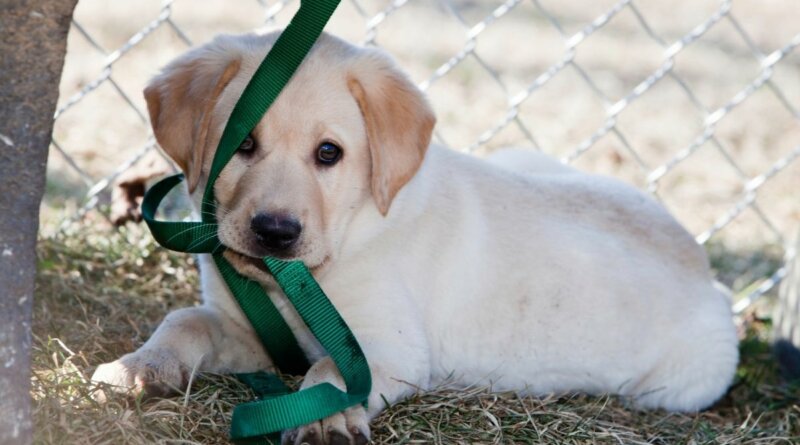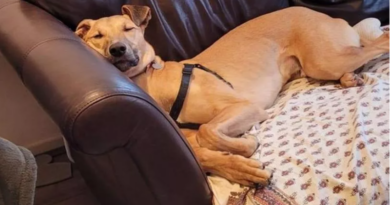How To Stop Your Dog From Pulling on the Leash
This post may contain affiliate links. We may earn money or products from the companies mentioned in this post.
You want to go on a leisurely walk with your dog Max. But Max has other intentions.
You start out the door and Max is pulling you as if he were a sled dog at the Iditarod–and you’re the sled.
Now you’re wondering…How do I stop my dog from pulling on the leash?
There are things you can do to avoid this scenario.

We all want that ideal dog that walks at a trot by our side.
However, in order to have a dog that walks without pulling requires a lot of training and patience.
Today’s article is our guide on how to stop a dog from pulling on the leash. Let’s get started.
Why Does Your Dog Pull on the Leash?
Pulling on a leash is natural canine behavior. They want to explore the sights, sounds, and scents in their world.
They do it because it works: they get to reach their desired places more quickly.
It’s also self-rewarding when we let them pull, so they repeat the behavior.
Because it’s so self-rewarding and fun for the dog, it’s also a very hard habit to break. But it can be done.
They don’t pull to be dominant, alpha, or pack leaders.
I’ve rescued a number of adult dogs who pulled on the leash.
Spencer, a golden retriever who came to me at about three years old, had no leash manners.
It wasn’t his fault. No one taught him to walk on a loose leash.
But he was about 75 pounds of muscle and could easily pull until trained to do otherwise.
And our adventure of training him to walk politely on a leash took time. And a ton of patience.
But it paid off. Spencer LOVED his walks and looked forward to them.
When I took his leash out, he’d go to the door and look at me with puppy eyes–pleading to go on his next adventure.
And I also enjoyed his walks then.
Why Teach Your Dog To Walk on a Loose Leash?
The main reason to teach your dog to walk on a loose leash is for everyone’s safety.
A dog can pull his owner down. Or he could get loose if his owners can’t hold onto him.
It’s also dangerous for the dog. We’ve all seen dogs pulling on a leash as they choke and gasp for air.
This can harm the dog by restricting the blood flow to his head.
It can also damage his trachea. Small dogs are especially susceptible to this.
Methods To Stop Your Dog From Pulling on a Leash
There are numerous techniques you can use to stop your dog from pulling on his leash.
These are tried-and-true methods. But, like all training, they require patience and consistency.
Everyone who walks your dog–family members, friends, dog walkers–must be consistent.
And there’s no cookie cutter approach. Each dog’s an individual.
If one method doesn’t work, another will.
Four on the Floor To Start
When most dogs see you take out their leash, they go ballistic. They jump around, spin, whine, and bark.
If you take your dog out in that excited state, your walk is already off to a bad start. And it will probably go down from there.
It’s best to do practice training exercises by the door so that when you need your dog to be calm for a walk, he’ll be able to.
I recommend physically or mentally exercising your dog prior to practicing this training.
Always try to set your dog up to succeed.
You can play fetch or have him work a puzzle toy first. Eventually, he should be able to be calm without first exercising him.
So train your dog to be calm at the door before you go out on your trek through the neighborhood.
Don’t take him on a walk until he has some impulse control and isn’t over-stimulated.
To teach him to be calm before you begin your walk, practice the following training exercise.
Take out his leash. Wait until he’s calm to attempt to attach it to his harness or collar.
If he’s over-stimulated, don’t attach the leash. Just hold it up or put it on a table.
Then, when he’s calm, try attaching it again.
Repeat again until you can attach the leash when he’s calm.
This training set-up exercise helps your dog think about how he gets the reward of a walk: by being calm first.
If needed, you can tell him to sit first if he’s able to sit and remain calm.
Equipment
Special training equipment can help you in your goal to take a walk without your dog pulling.
I believe in setting up your dog to succeed and using specialized equipment to help.
That said, no piece of training equipment replaces the need to also train your dog to walk well on a lead.
There are many options.
I prefer a properly fitted anti-pull harness for most dogs.
The Freedom Harness has two places where you clip a leash. The harness comes with a leash that has two ends with clasps to clip onto the harness.
The Sporn harness is another choice that can work well. If the dog pulls, the harness tightens under the dog’s arms, discouraging pulling.
The Easy Walk harness is a front clip harness where the Martingale closure in front tightens when a dog pulls, discouraging pulling.
There are many other anti-pull harness choices but most work on the principles of the above harnesses.
Other devices that can help to deter pulling include head halters like the Gentle Leader head halter and one made by Halti.
When walking, use a six-foot leash, not a long-line or flexi lead. You can use a four-foot lead if you have a larger breed, not a small dog.
You don’t want the leash to be tight and want to hold it so that there’s a little slack.
Teach a Command for Loose Leash Walking
You want your dog to know what’s expected. Teaching a command will help make your walks enjoyable.
I use “let’s go” followed by the dog’s name. After I say the cue, I start walking.
I don’t expect a dog to be in perfect heel position right next to my left leg. I want the walk to be enjoyable for both of us.
As long as the dog’s not pulling, he can be slightly ahead or behind me.
PRO TRAINER TIP: Have many small pieces of treats ready to reward when your pup’s doing something right. Dogs will repeat behavior that’s rewarded. The treats shouldn’t be larger than the size of a pea.
- Choose a Side. You need to choose whether you want your pup to walk on your left or right side. It’s important that everyone’s consistent or your dog will be confused.
- Work on Your Dog’s Attention. In all training, it’s important to start with and keep your dog’s attention on you.
- Normal Pace. Start walking at your normal pace with a stride that’s appropriate for your dog.
If you have a smaller dog like a shih tzu, you’d walk with a smaller stride and at a slower pace than if you’re walking a golden retriever.
As your dog is starting to pull towards the end of the leash, you can add the cue “easy” and praise and reward when he turns to you or takes a step back.
- Turns. Making turns helps a dog learn not to pull on a leash.
You can make about-turns, where you make a 180-degree turn in the opposite direction from where you were walking.
When I’m training a new dog to learn to pay attention to turns, I’ll repeat the “let’s go” cue right before I make the turn.
You can then add some left turns and right turns in the same manner.
When starting out training, make just about turns to begin. But when you make the turn, don’t tug on the leash.
Over a few sessions, you can add other turns.
With my golden retriever Riley, I did many about turns and left turns, because he tended to forge ahead. (He walks on my left side.) By making these turns, he learned not to pull ahead.
Of course, I also made some right turns.
- Changes of Pace, As you progress in your training, you can incorporate some changes of pace.
You can go from a normal pace to a slower pace, then back to normal. Then add a few steps of a faster pace, then go back to a normal pace.
You don’t want to run; it’s just a slight change in speed.
Changes of pace and direction help a dog learn positioning and keeps him interested.
- “Be a Tree.” Of course you don’t have to become a plant to train your dog.
But there’s a technique where you plant your feet and not move forward until your dog calms down and walks back toward you.
When he isn’t pulling, you can move forward again.
Praise and reward when he’s not trying to pull. If you do this consistently, he should learn not to pull.
It’s a very slow technique, but it works.
I use a combination of this and turns to teach a dog not to pull.
It all depends what’s effective for the specific dog I’m training.
- Keep Him Motivated. When your dog understands what “let’s go” means, become more unpredictable so that he doesn’t become bored. You want to keep his attention.
Make various turns. Walk in a circle. Walk in a figure-eight pattern.
You get the idea.
- Play the “Find Me” Game. Take several steps backward from your dog.
Say “yes!” and reward when he follows you. This can help him focus and move with you.
- Reward Good Behavior. Have treats readily available from your pocket or from a bait bag.
You want to be able to reward your dog immediately after he performs the desired behavior. When you’re first training, reward every few steps when he’s not pulling.
You want to mark the desired behavior and treat when your dog’s in the proper position.
Say “yes!” and give a treat.
Use a happy voice that’s not overly excited or you may cause your dog to become overly stimulated.
You can also lure your dog into position by having him walk next to you and holding a treat in the hand next to him just above his nose.
Tell him “let’s go” and start walking. Praise and reward when he’s not pulling.
But don’t use this technique if he starts jumping up for the treat.
Treat more often when your dog’s first learning.
After he understands what’s expected and is loose leash walking more often, you can start to give treats less often.
But still praise and still give some treats periodically.
- Exercise Your Dog Prior to the Walk. I know this sounds silly, because a main reason for the walk is to exercise your dog.
But we’re always doing all that we can to set up our dogs to succeed.
So, if you can have your dog fetch or do a little training to take the edge off his excess energy, it will help when you’re training him to walk on a loose leash.
- Teach Your Dog To Heel. “Heel” technically means that your dog is in position next to your left leg, with his neck/shoulder area aligned with you. (Of course, if you want to, he can learn this positioning on your right side.)
As I said above, I never make a dog heel during an entire walk. But after he learns to heel, you can do a little heeling on your walk for impulse control.
- Use Short Training Sessions Without Distractions. When practicing loose leash walking, train in short sessions of five to 10 minutes to begin with.
Also, start without distractions. I like to start training inside so that the dog won’t be distracted and can focus on the training.
Then, after he understands what’s expected when you say “let’s go,” you can train in more distracting locations, such as your yard.
Eventually, once he understands working outside, use the commands on your walk.
Of course, if pulling on a leash has become a habit, it will probably take longer to teach him to walk on a loose leash.
What NOT To Do When Your Dog Is Pulling On Leash
There are some techniques and training methods that shouldn’t be used. They are inappropriate and can even backfire on you.
Don’t Hold the Leash Tight
Even though it seems like holding a leash tightly would help your dog not pull, nothing could be further from the truth.
Dogs will automatically pull against a tight leash. It’s called the opposition reflex. Even if they appear to be choking, dogs pull.
Don’t Be Inconsistent
Don’t let your dog pull some times but not others. Everyone walking him has to be consistent.
Don’t Use Longlines or Flexis
You don’t want to use a leash longer than six feet to teach a dog how to walk on a loose leash.
You have to hold the leash and have just a little slack, so a longline wouldn’t work well.
And flexi leashes can be dangerous. They can wrap around you or the dog and cause serious injury. Also, they have a plastic handle that’s difficult to maneuver.
Don’t Use Painful or Harsh Methods
It’s important not to use harsh methods like jerking the leash, which can damage your dog physically.
Also, using choke, prong, or electric collars shouldn’t be used. And don’t yell at him for pulling.
Training shouldn’t be harsh or abusive.
Working with our dogs should further the bond with our pups.
Final Thoughts
It’s important to train our dogs to walk on a loose leash and not pull.
Not only is it safer but it also makes the walk more enjoyable.
Have you trained your dog to walk on a loose leash?
If so, what techniques did you use?
Tell us in the comment section below.
Save To Pinterest

Top Picks For Our Puppies
- BEST PUPPY TOY
We Like: Snuggle Puppy w/ Heart Beat & Heat Pack – Perfect for new puppies. We get all of our Service Dog pups a Snuggle Puppy. - BEST DOG CHEW
We Like: Best Bully Sticks – All of our puppies love to bite, nip, and chew. We love using Bully Sticks to help divert these unwanted behaviors. - BEST DOG TREATS
We Like: Wellness Soft Puppy Bites – One of our favorite treats for training our service dog puppies. - BEST FRESH DOG FOOD
We Like: The Farmer’s Dog – A couple months ago we started feeding Raven fresh dog food and she loves it! Get 50% off your first order of The Farmer’s Dog.
Check out more of our favorites on our New Puppy Checklist.




